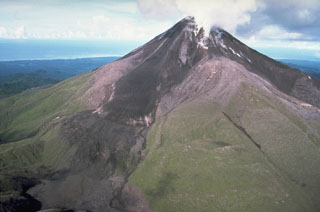Report on Bagana (Papua New Guinea) — April 1990
Bulletin of the Global Volcanism Network, vol. 15, no. 4 (April 1990)
Managing Editor: Lindsay McClelland.
Bagana (Papua New Guinea) Rockfalls from blocky lava flow; ash column
Please cite this report as:
Global Volcanism Program, 1990. Report on Bagana (Papua New Guinea) (McClelland, L., ed.). Bulletin of the Global Volcanism Network, 15:4. Smithsonian Institution. https://doi.org/10.5479/si.GVP.BGVN199004-255020
Bagana
Papua New Guinea
6.137°S, 155.196°E; summit elev. 1855 m
All times are local (unless otherwise noted)
"In the current period of social unrest on Bougainville Island Island, no instrumental data is being recorded, and the only information on Bagana's activity is from visual observations from a site 15 km SSW of the volcano.
"When observations resumed on 3 April, Bagana was in a fairly high level of activity. Thick, white, ash-laden vapour was being forcefully emitted from the summit area. [An explosion in the summit crater] on the 3rd produced a black column, and loud rumbling noises were heard until the 4th.
"Numerous rockfalls (including daytime glowing avalanches) were observed in early April on the SE and E flanks of the cone, where a slowly progressing blocky lava flow has been active since 1987. This activity together with the reportedly stronger vapour and ash emission may suggest that a new pulse of viscous lava extrusion took place in the summit crater in the first few days of April.
"The mountain was often covered by atmospheric clouds or rainstorms, but a weak, night, summit glow was intermittently observed until the 21st, with occasional (night-glowing) rockfalls occurring until the 24th."
Geological Summary. Bagana volcano, in a remote portion of central Bougainville Island, is frequently active. This massive symmetrical cone was largely constructed by an accumulation of viscous andesitic lava flows. The entire edifice could have been constructed in about 300 years at its present rate of lava production. Eruptive activity is characterized by non-explosive effusion of viscous lava that maintains a small lava dome in the summit crater, although occasional explosive activity produces pyroclastic flows. Lava flows with tongue-shaped lobes up to 50 m thick and prominent levees descend the flanks on all sides.
Information Contacts: P. de Saint-Ours and C. McKee, RVO.

